目录
1.用户登录认证流程
1.1 生成认证Token
1.2 用户登录认证
1.2.1 SecurityManager login流程解析
1.2.1.1 authenticate方法进行登录认证
1.2.1.1.1 单Realm认证
1.2.1.2 认证通过后创建登录用户对象
1.2.1.2.1 复制SubjectContext
1.2.1.2.2 对subjectContext设置securityManager
1.2.1.2.3 对subjectContext设置session
1.2.1.2.4 对subjectContext设置Principals
1.2.1.2.5 根据subjectContext创建Subject
1.2.1.2.6 保存Subject
Shiro作为一款比较流行的登录认证、访问控制安全框架,被广泛应用在程序员社区;Shiro登录验证、访问控制、Session管理等流程内部都是委托给SecurityManager安全管理器来完成的,SecurityManager安全管理器上篇文章已经进行了详细解析,详见:Shiro框架:Shiro SecurityManager安全管理器解析-CSDN博客,在此基础上,本篇文章继续对Shiro关联链路处理流程之一---登录认证流程 进行解析;
想要深入了解Shiro框架整体原理,可移步:
Shiro框架:ShiroFilterFactoryBean过滤器源码解析-CSDN博客、
Shiro框架:Shiro内置过滤器源码解析-CSDN博客
1.用户登录认证流程
在Shiro框架:Shiro内置过滤器源码解析-CSDN博客内置过滤器分析中,我们知道用户执行登录的认证操作是在过滤器FormAuthenticationFilter中执行的,如下:
protected boolean onAccessDenied(ServletRequest request, ServletResponse response) throws Exception {if (isLoginRequest(request, response)) {if (isLoginSubmission(request, response)) {if (log.isTraceEnabled()) {log.trace("Login submission detected. Attempting to execute login.");}return executeLogin(request, response);} else {if (log.isTraceEnabled()) {log.trace("Login page view.");}//allow them to see the login page ;)return true;}} else {if (log.isTraceEnabled()) {log.trace("Attempting to access a path which requires authentication. Forwarding to the " +"Authentication url [" + getLoginUrl() + "]");}saveRequestAndRedirectToLogin(request, response);return false;}}
登录认证操作是在executeLogin方法中完成的:
protected boolean executeLogin(ServletRequest request, ServletResponse response) throws Exception {AuthenticationToken token = createToken(request, response);if (token == null) {String msg = "createToken method implementation returned null. A valid non-null AuthenticationToken " +"must be created in order to execute a login attempt.";throw new IllegalStateException(msg);}try {Subject subject = getSubject(request, response);subject.login(token);return onLoginSuccess(token, subject, request, response);} catch (AuthenticationException e) {return onLoginFailure(token, e, request, response);}}上述源码的执行过程表示为时序图会更直观,时序图如下:
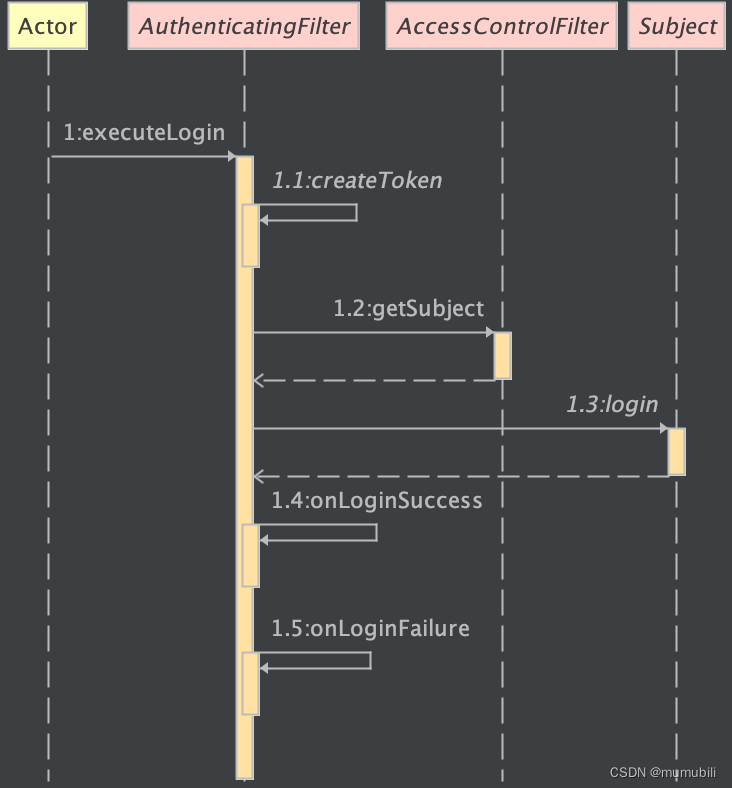
该认证过程主要包含以下几个部分:
- 根据用户名密码等生成认证Token
- 获取当前登录用户Subject
- 调用Subject的login方法进行登录认证
- 其它的登录成功、或登录失败的拦截方法
下面主要对生成认证Token和用户登录认证实现进行详细说明;
1.1 生成认证Token
createToken的实现在FormAuthenticationFilter内,如下:
这里用户名和密码是通过request请求对象获取的:
protected AuthenticationToken createToken(ServletRequest request, ServletResponse response) {String username = getUsername(request);String password = getPassword(request);return createToken(username, password, request, response);}在父类AuthenticatingFilter中进一步实现如下,这里构造了UsernamePasswordToken类,表示采用用户名密码的认证方式;
protected AuthenticationToken createToken(String username, String password,ServletRequest request, ServletResponse response) {boolean rememberMe = isRememberMe(request);String host = getHost(request);return createToken(username, password, rememberMe, host);}protected AuthenticationToken createToken(String username, String password,boolean rememberMe, String host) {return new UsernamePasswordToken(username, password, rememberMe, host);}图示UsernamePasswordToken的继承结构:
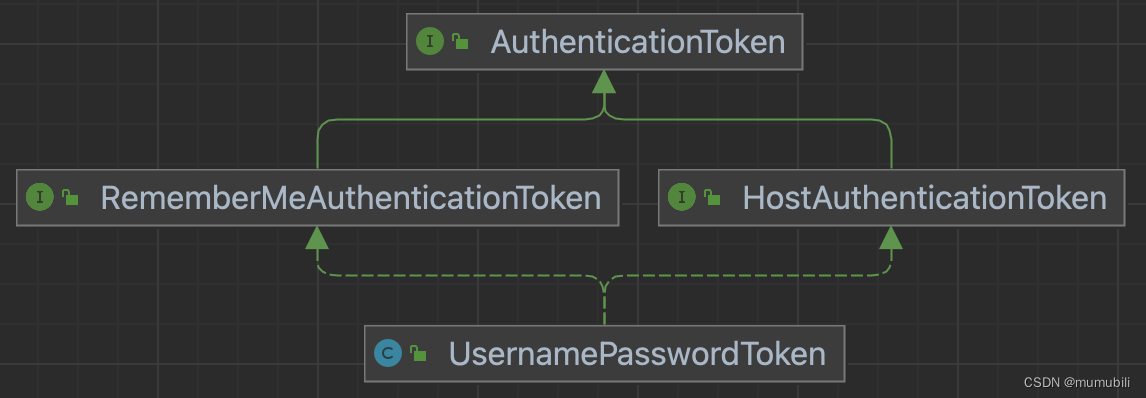
1.2 用户登录认证
在Subject的login的具体实现如下:
- 实际的login是委托给SecurityManager完成的
- 登录成功后设置当前登录对象为认证成功
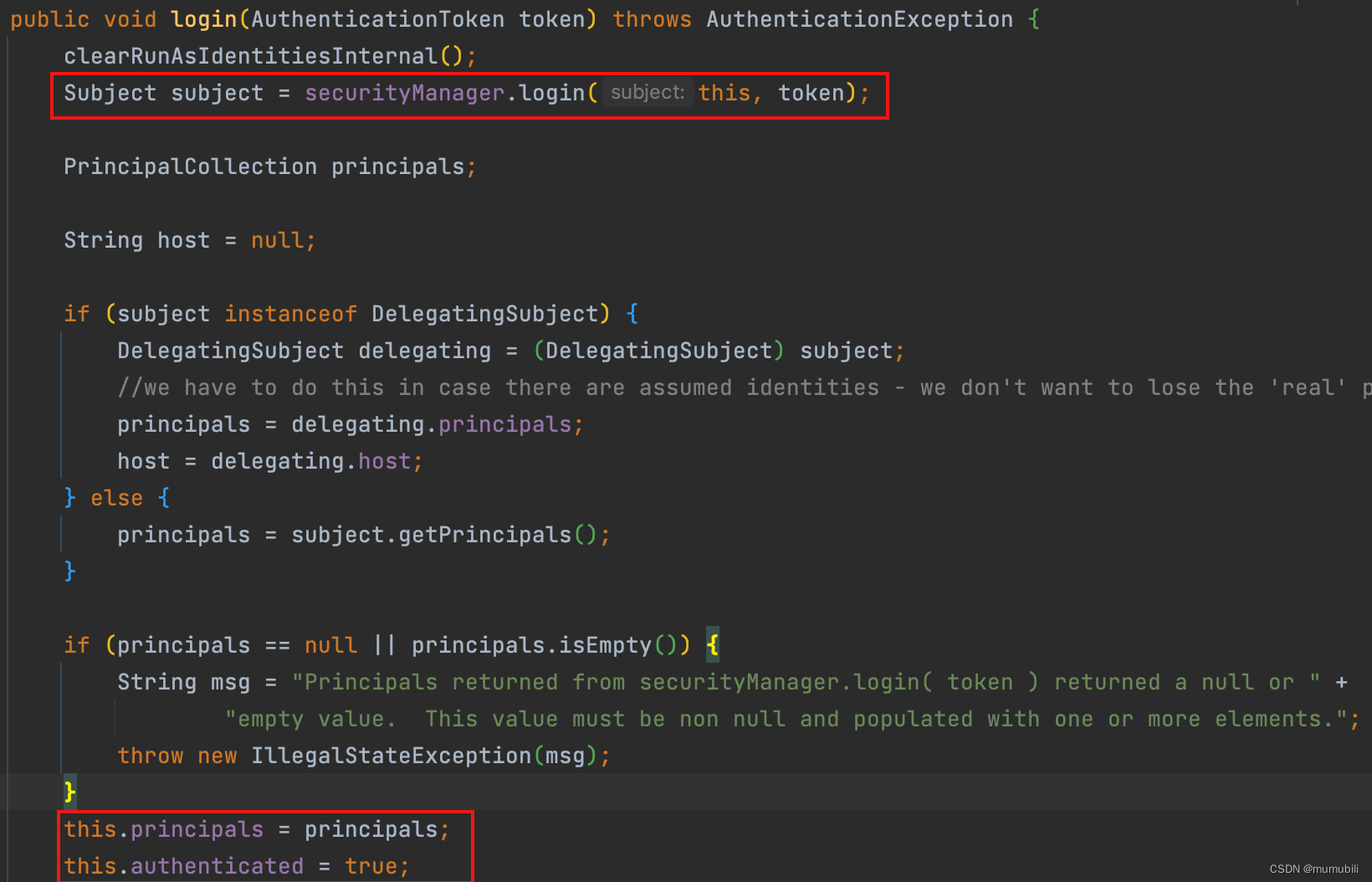
下面主要对SecurityManager的login方法进行具体分析;
1.2.1 SecurityManager login流程解析
login方法具体实现如下:
public Subject login(Subject subject, AuthenticationToken token) throws AuthenticationException {AuthenticationInfo info;try {info = authenticate(token);} catch (AuthenticationException ae) {try {onFailedLogin(token, ae, subject);} catch (Exception e) {if (log.isInfoEnabled()) {log.info("onFailedLogin method threw an " +"exception. Logging and propagating original AuthenticationException.", e);}}throw ae; //propagate}Subject loggedIn = createSubject(token, info, subject);onSuccessfulLogin(token, info, loggedIn);return loggedIn;}上述登录流程主要包含2部分内容:
- 通过authenticate方法进行登录认证
- 认证通过后创建登录用户对象
下面分别进行展开分析;
1.2.1.1 authenticate方法进行登录认证
具体的authenticate实现内部又委托给了认证器Authenticator来实现,具体的认证器为ModularRealmAuthenticator,其继承结构如下:
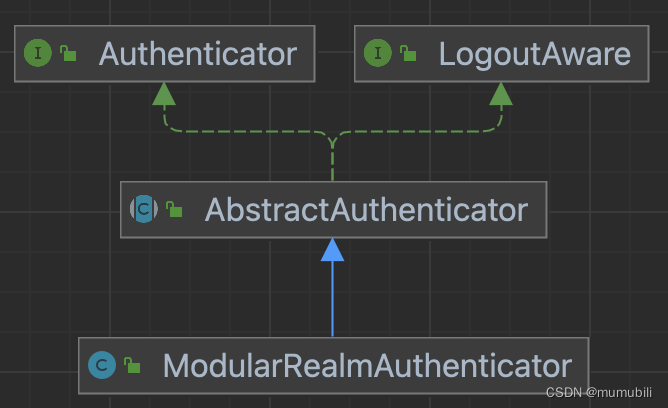
authenticate方法具体实现是在父类AbstractAuthenticator中,如下:
public final AuthenticationInfo authenticate(AuthenticationToken token) throws AuthenticationException {if (token == null) {throw new IllegalArgumentException("Method argument (authentication token) cannot be null.");}log.trace("Authentication attempt received for token [{}]", token);AuthenticationInfo info;try {info = doAuthenticate(token);if (info == null) {String msg = "No account information found for authentication token [" + token + "] by this " +"Authenticator instance. Please check that it is configured correctly.";throw new AuthenticationException(msg);}} catch (Throwable t) {AuthenticationException ae = null;if (t instanceof AuthenticationException) {ae = (AuthenticationException) t;}if (ae == null) {//Exception thrown was not an expected AuthenticationException. Therefore it is probably a little more//severe or unexpected. So, wrap in an AuthenticationException, log to warn, and propagate:String msg = "Authentication failed for token submission [" + token + "]. Possible unexpected " +"error? (Typical or expected login exceptions should extend from AuthenticationException).";ae = new AuthenticationException(msg, t);if (log.isWarnEnabled())log.warn(msg, t);}try {notifyFailure(token, ae);} catch (Throwable t2) {if (log.isWarnEnabled()) {String msg = "Unable to send notification for failed authentication attempt - listener error?. " +"Please check your AuthenticationListener implementation(s). Logging sending exception " +"and propagating original AuthenticationException instead...";log.warn(msg, t2);}}throw ae;}log.debug("Authentication successful for token [{}]. Returned account [{}]", token, info);notifySuccess(token, info);return info;}通过方法doAuthenticate对认证Token进行认证,通过notifySuccess、notifyFailure监听认证通过或失败的事件并调用注册的监听器;
方法doAuthenticate的具体实现是在子类完成的,如下:
protected AuthenticationInfo doAuthenticate(AuthenticationToken authenticationToken) throws AuthenticationException {assertRealmsConfigured();Collection<Realm> realms = getRealms();if (realms.size() == 1) {return doSingleRealmAuthentication(realms.iterator().next(), authenticationToken);} else {return doMultiRealmAuthentication(realms, authenticationToken);}}这里首先获取已注册的安全组件Realm,其注册过程是在RealmSecurityManager初始化的过程中完成的(对SecurityManager安全管理器的处理过程感兴趣可以参见:Shiro框架:Shiro SecurityManager安全管理器解析-CSDN博客)
然后根据Realm的个数分别执行单Realm认证或多Realm认证,这里已单Realm认证为例进行说明,多Realm认证类似;
1.2.1.1.1 单Realm认证
通过doSingleRealmAuthentication方法完成单Realm认证,实现如下:
protected AuthenticationInfo doSingleRealmAuthentication(Realm realm, AuthenticationToken token) {if (!realm.supports(token)) {String msg = "Realm [" + realm + "] does not support authentication token [" +token + "]. Please ensure that the appropriate Realm implementation is " +"configured correctly or that the realm accepts AuthenticationTokens of this type.";throw new UnsupportedTokenException(msg);}AuthenticationInfo info = realm.getAuthenticationInfo(token);if (info == null) {String msg = "Realm [" + realm + "] was unable to find account data for the " +"submitted AuthenticationToken [" + token + "].";throw new UnknownAccountException(msg);}return info;}这里Reaml接口包含一整套的继承层次实现,如下,这里不过多展开解析;
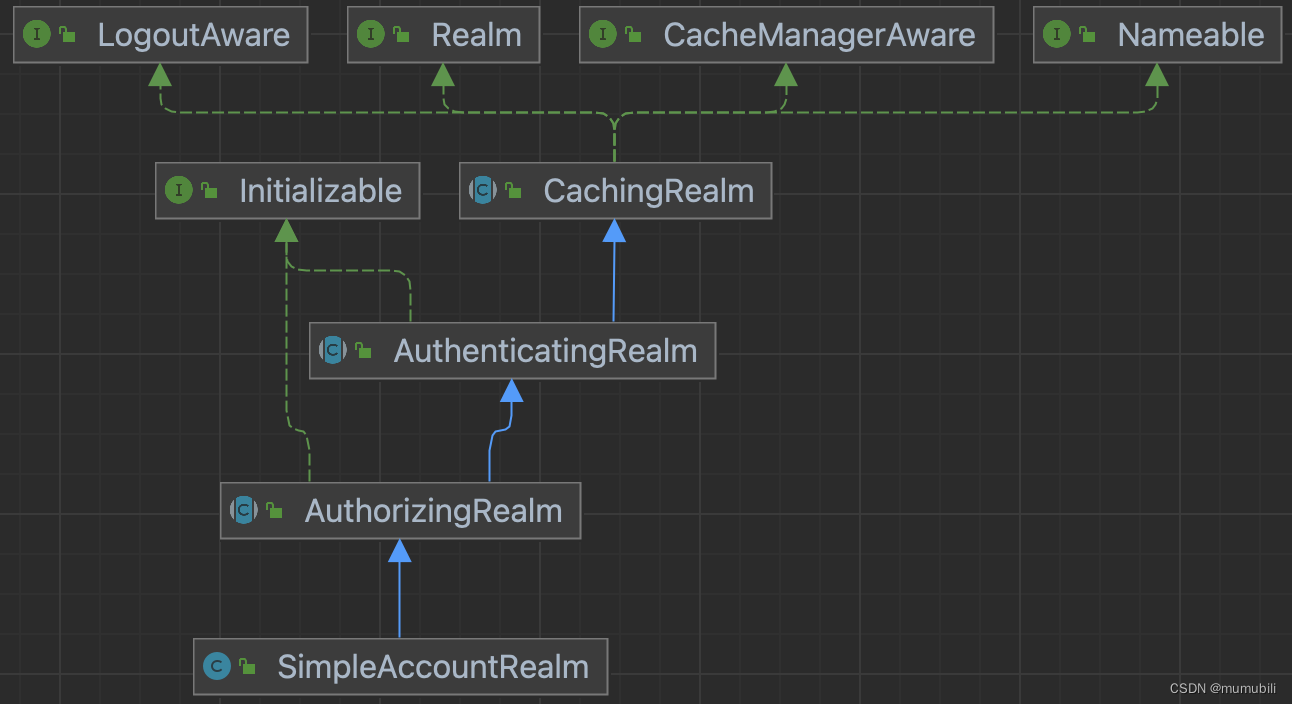
getAuthenticationInfo是在AuthenticatingRealm中完成的,如下:
public final AuthenticationInfo getAuthenticationInfo(AuthenticationToken token) throws AuthenticationException {AuthenticationInfo info = getCachedAuthenticationInfo(token);if (info == null) {//otherwise not cached, perform the lookup:info = doGetAuthenticationInfo(token);log.debug("Looked up AuthenticationInfo [{}] from doGetAuthenticationInfo", info);if (token != null && info != null) {cacheAuthenticationInfoIfPossible(token, info);}} else {log.debug("Using cached authentication info [{}] to perform credentials matching.", info);}if (info != null) {assertCredentialsMatch(token, info);} else {log.debug("No AuthenticationInfo found for submitted AuthenticationToken [{}]. Returning null.", token);}return info;}这里首先获取AuthenticationInfo对象,要么从缓存中获取,要么通过引入的抽象方法doGetAuthenticationInfo获取(交由应用层子类具体实现);
获取到AuthenticationInfo后,将其余用户录入的登录Token进行比对,这部分具体是方法assertCredentialsMatch完成的,具体如下:
protected void assertCredentialsMatch(AuthenticationToken token, AuthenticationInfo info) throws AuthenticationException {CredentialsMatcher cm = getCredentialsMatcher();if (cm != null) {if (!cm.doCredentialsMatch(token, info)) {//not successful - throw an exception to indicate this:String msg = "Submitted credentials for token [" + token + "] did not match the expected credentials.";throw new IncorrectCredentialsException(msg);}} else {throw new AuthenticationException("A CredentialsMatcher must be configured in order to verify " +"credentials during authentication. If you do not wish for credentials to be examined, you " +"can configure an " + AllowAllCredentialsMatcher.class.getName() + " instance.");}}这里获取了默认的匹配器SimpleCredentialsMatcher,并调用doCredentialsMatch方法进行匹配,匹配实现如下:
public boolean doCredentialsMatch(AuthenticationToken token, AuthenticationInfo info) {Object tokenCredentials = getCredentials(token);Object accountCredentials = getCredentials(info);return equals(tokenCredentials, accountCredentials);}首先获取Credentials,也即用户密码,然后调用equals方法进行匹配,如下通过字节流的方式进行比对(主要是为了安全考虑,系统处理时采用非明文形式)。
protected boolean equals(Object tokenCredentials, Object accountCredentials) {if (log.isDebugEnabled()) {log.debug("Performing credentials equality check for tokenCredentials of type [" +tokenCredentials.getClass().getName() + " and accountCredentials of type [" +accountCredentials.getClass().getName() + "]");}if (isByteSource(tokenCredentials) && isByteSource(accountCredentials)) {if (log.isDebugEnabled()) {log.debug("Both credentials arguments can be easily converted to byte arrays. Performing " +"array equals comparison");}byte[] tokenBytes = toBytes(tokenCredentials);byte[] accountBytes = toBytes(accountCredentials);return MessageDigest.isEqual(tokenBytes, accountBytes);} else {return accountCredentials.equals(tokenCredentials);}}至此,用户账号密码匹配完成,匹配完成后,会重新创建用户登录对象,并更新用户状态等,下面具体分析;
1.2.1.2 认证通过后创建登录用户对象
认证通过后创建Subject的实现如下:
protected Subject createSubject(AuthenticationToken token, AuthenticationInfo info, Subject existing) {SubjectContext context = createSubjectContext();context.setAuthenticated(true);context.setAuthenticationToken(token);context.setAuthenticationInfo(info);if (existing != null) {context.setSubject(existing);}return createSubject(context);}@Overrideprotected SubjectContext createSubjectContext() {return new DefaultWebSubjectContext();}这里创建了DefaultWebSubjectContext,用户Subject创建,其中设置了认证状态、认证Token、已认证信息,然后调用createSubject方法继续进行构造,如下:
public Subject createSubject(SubjectContext subjectContext) {//create a copy so we don't modify the argument's backing map:SubjectContext context = copy(subjectContext);//ensure that the context has a SecurityManager instance, and if not, add one:context = ensureSecurityManager(context);//Resolve an associated Session (usually based on a referenced session ID), and place it in the context before//sending to the SubjectFactory. The SubjectFactory should not need to know how to acquire sessions as the//process is often environment specific - better to shield the SF from these details:context = resolveSession(context);//Similarly, the SubjectFactory should not require any concept of RememberMe - translate that here first//if possible before handing off to the SubjectFactory:context = resolvePrincipals(context);Subject subject = doCreateSubject(context);//save this subject for future reference if necessary://(this is needed here in case rememberMe principals were resolved and they need to be stored in the//session, so we don't constantly rehydrate the rememberMe PrincipalCollection on every operation).//Added in 1.2:save(subject);return subject;}如上创建过程包含了以下几部分,分别进行分析;
1.2.1.2.1 复制SubjectContext
对subjectContext调用复制构造方法进行复制,subjectContext底层通过backingMap保存上下文信息:
public MapContext(Map<String, Object> map) {this();if (!CollectionUtils.isEmpty(map)) {this.backingMap.putAll(map);}}1.2.1.2.2 对subjectContext设置securityManager
获取securityManager的顺序如下:
- 首先从subjectContext中获取
- 若无,则从当前线程上下文中获取
- 否则将当前securityManager设置到subjectContext中
protected SubjectContext ensureSecurityManager(SubjectContext context) {if (context.resolveSecurityManager() != null) {log.trace("Context already contains a SecurityManager instance. Returning.");return context;}log.trace("No SecurityManager found in context. Adding self reference.");context.setSecurityManager(this);return context;} public SecurityManager resolveSecurityManager() {SecurityManager securityManager = getSecurityManager();if (securityManager == null) {if (log.isDebugEnabled()) {log.debug("No SecurityManager available in subject context map. " +"Falling back to SecurityUtils.getSecurityManager() lookup.");}try {securityManager = SecurityUtils.getSecurityManager();} catch (UnavailableSecurityManagerException e) {if (log.isDebugEnabled()) {log.debug("No SecurityManager available via SecurityUtils. Heuristics exhausted.", e);}}}return securityManager;}1.2.1.2.3 对subjectContext设置session
解析session方法如下,其中session的解析顺序为:
- 首先从subjectContext获取session,判断是否已设置session(见源码2)
- 否则,通过subjectContext中保存的Subject对象获取关联的session(见源码2)
- 其次,通过sessionManager Session管理器获取(见源码3)
- Web服务中,具体的Session管理器为ServletContainerSessionManager,尝试从request请求中获取Servlet管理的Session;(见源码4)
源码1:
protected SubjectContext resolveSession(SubjectContext context) {if (context.resolveSession() != null) {log.debug("Context already contains a session. Returning.");return context;}try {//Context couldn't resolve it directly, let's see if we can since we have direct access to //the session manager:Session session = resolveContextSession(context);if (session != null) {context.setSession(session);}} catch (InvalidSessionException e) {log.debug("Resolved SubjectContext context session is invalid. Ignoring and creating an anonymous " +"(session-less) Subject instance.", e);}return context;}源码2:
public Session resolveSession() {Session session = getSession();if (session == null) {//try the Subject if it exists:Subject existingSubject = getSubject();if (existingSubject != null) {session = existingSubject.getSession(false);}}return session;}源码3:
protected Session resolveContextSession(SubjectContext context) throws InvalidSessionException {SessionKey key = getSessionKey(context);if (key != null) {return getSession(key);}return null;}public Session getSession(SessionKey key) throws SessionException {return this.sessionManager.getSession(key);}源码4: ServletContainerSessionManager获取Session
public Session getSession(SessionKey key) throws SessionException {if (!WebUtils.isHttp(key)) {String msg = "SessionKey must be an HTTP compatible implementation.";throw new IllegalArgumentException(msg);}HttpServletRequest request = WebUtils.getHttpRequest(key);Session session = null;HttpSession httpSession = request.getSession(false);if (httpSession != null) {session = createSession(httpSession, request.getRemoteHost());}return session;}1.2.1.2.4 对subjectContext设置Principals
resolvePrincipals方法实现如下,这里获取Principals的顺序为:
- 先从SubjectContext中直接获取Principals(见源码2)
- 否则,通过SubjectContext中已认证的AuthenticationInfo获取(见源码2)
- 其次,通过SubjectContext中的Subject获取(见源码2)
- 再次,通过SubjectContext中的Session获取(见源码2)
- 最后,通过RememberMeManager中的Cookie中获取
源码1:
protected SubjectContext resolvePrincipals(SubjectContext context) {PrincipalCollection principals = context.resolvePrincipals();if (isEmpty(principals)) {log.trace("No identity (PrincipalCollection) found in the context. Looking for a remembered identity.");principals = getRememberedIdentity(context);if (!isEmpty(principals)) {log.debug("Found remembered PrincipalCollection. Adding to the context to be used " +"for subject construction by the SubjectFactory.");context.setPrincipals(principals);} else {log.trace("No remembered identity found. Returning original context.");}}return context;}源码2:从SubjectContext获取Principals
public PrincipalCollection resolvePrincipals() {PrincipalCollection principals = getPrincipals();if (isEmpty(principals)) {//check to see if they were just authenticated:AuthenticationInfo info = getAuthenticationInfo();if (info != null) {principals = info.getPrincipals();}}if (isEmpty(principals)) {Subject subject = getSubject();if (subject != null) {principals = subject.getPrincipals();}}if (isEmpty(principals)) {//try the session:Session session = resolveSession();if (session != null) {principals = (PrincipalCollection) session.getAttribute(PRINCIPALS_SESSION_KEY);}}return principals;}1.2.1.2.5 根据subjectContext创建Subject
如下,通过createSubject创建了WebDelegatingSubject对象;
public Subject createSubject(SubjectContext context) {if (!(context instanceof WebSubjectContext)) {return super.createSubject(context);}WebSubjectContext wsc = (WebSubjectContext) context;SecurityManager securityManager = wsc.resolveSecurityManager();Session session = wsc.resolveSession();boolean sessionEnabled = wsc.isSessionCreationEnabled();PrincipalCollection principals = wsc.resolvePrincipals();boolean authenticated = wsc.resolveAuthenticated();String host = wsc.resolveHost();ServletRequest request = wsc.resolveServletRequest();ServletResponse response = wsc.resolveServletResponse();return new WebDelegatingSubject(principals, authenticated, host, session, sessionEnabled,request, response, securityManager);}1.2.1.2.6 保存Subject
Subject保存是通过DefaultSubjectDAO完成的,
如下,通过saveToSession方法保存Principals和认证状态到Session中;
protected void saveToSession(Subject subject) {//performs merge logic, only updating the Subject's session if it does not match the current state:mergePrincipals(subject);mergeAuthenticationState(subject);}这里在保存Principals的过程中,如果Principals不为空,且非Servlet Session的条件下,这里会调用subject.getSession()方法创建shiro管理的native Session对象:

subject.getSession()方法实现如下:
public Session getSession() {return getSession(true);}public Session getSession(boolean create) {if (log.isTraceEnabled()) {log.trace("attempting to get session; create = " + create +"; session is null = " + (this.session == null) +"; session has id = " + (this.session != null && session.getId() != null));}if (this.session == null && create) {//added in 1.2:if (!isSessionCreationEnabled()) {String msg = "Session creation has been disabled for the current subject. This exception indicates " +"that there is either a programming error (using a session when it should never be " +"used) or that Shiro's configuration needs to be adjusted to allow Sessions to be created " +"for the current Subject. See the " + DisabledSessionException.class.getName() + " JavaDoc " +"for more.";throw new DisabledSessionException(msg);}log.trace("Starting session for host {}", getHost());SessionContext sessionContext = createSessionContext();Session session = this.securityManager.start(sessionContext);this.session = decorate(session);}return this.session;}如上,通过securityManager的start方法创建Session对象,start具体实现为 :
public Session start(SessionContext context) throws AuthorizationException {return this.sessionManager.start(context);}这里又委托给了Session管理器完成session创建,这里的Session管理器实现为AbstractNativeSessionManager,start方法实现如下:
public Session start(SessionContext context) {Session session = createSession(context);applyGlobalSessionTimeout(session);onStart(session, context);notifyStart(session);//Don't expose the EIS-tier Session object to the client-tier:return createExposedSession(session, context);}上述主要完成了以下几部分功能:
1. 通过createSession方法创建SimpleSession对象,其中包括了Session创建、Session保存到 sessionDAO中(比如保存到内存中的子类MemorySessionDAO,或者保存在数据库中的子类 EnterpriseCacheSessionDAO等),SessionId生成等操作;
图示sessionDAO的整体继承结构:
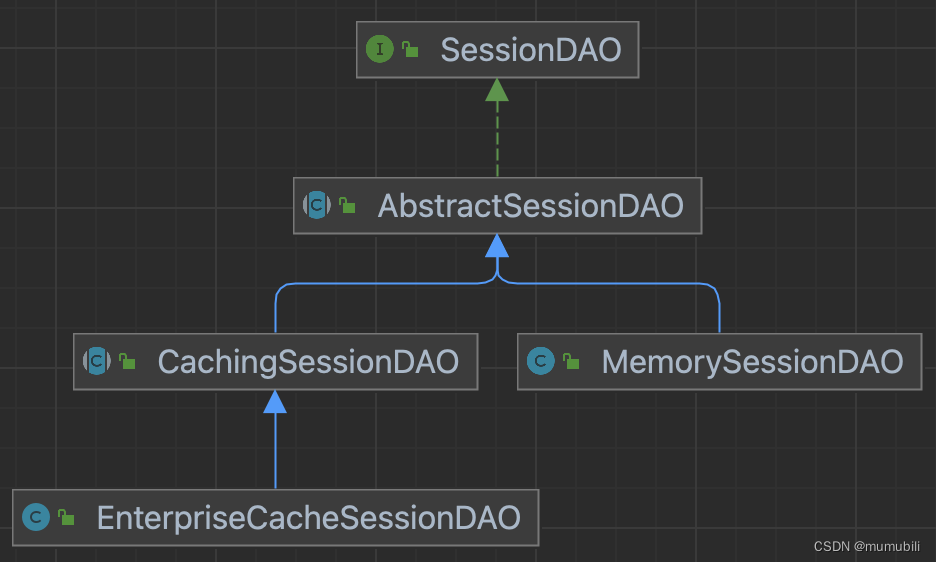
2. Session全局超时时间配置(默认超时时间为30min)
3. onStart将SessionId存储到Cookie中,如下:
private void storeSessionId(Serializable currentId, HttpServletRequest request, HttpServletResponse response) {if (currentId == null) {String msg = "sessionId cannot be null when persisting for subsequent requests.";throw new IllegalArgumentException(msg);}Cookie template = getSessionIdCookie();Cookie cookie = new SimpleCookie(template);String idString = currentId.toString();cookie.setValue(idString);cookie.saveTo(request, response);log.trace("Set session ID cookie for session with id {}", idString);}至此,用户登录认证过程完成了生成认证Token、通过Realm从应用中获取用户认证信息、用户认证Token匹配,以及认证成功后创建用户Subject对象、保存Subject到Session、SessionId保存到Cookie等操作。



)







搭建虚拟渗透实验室——安装Windows 7 靶机)


)




